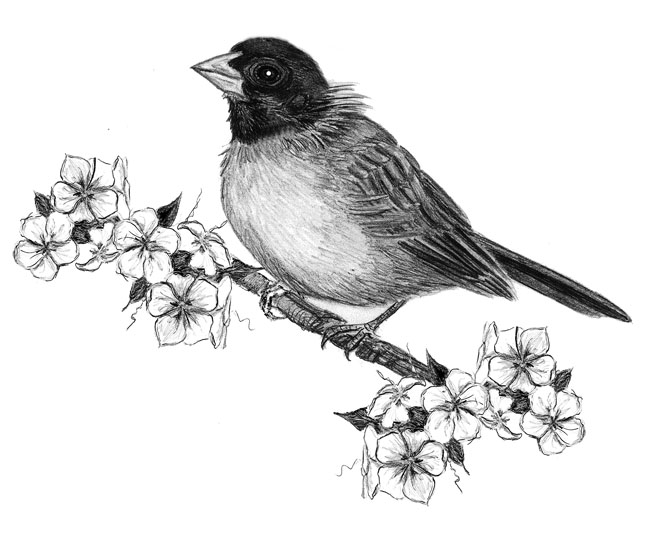
Dear Bird Folks,
I have an odd cardinal coming to my feeder. Instead of a red head and the typical cardinal crest, this bird’s head is small, round, black and featherless. Any idea what’s going on?
– Carol, Hyannis, MA
Not this one again, Carol,
When I first read your question I put it aside, because I was sure I had recently written an entire column on this exact topic. But then I looked it up and it turns out my idea of “recently” was actually September of 2005. Hmm. I wonder what I’ve been doing for the past decade. Perhaps spending too much time looking for Pokémon. Anyhow, there is nothing wrong with the cardinal you are describing; it’s just bald. Without its head feathers, you can see the bird’s skin, which is black. The mystery of balding birds has been a subject of much debate and right now there doesn’t seem to be an answer that everyone agrees with. This is good news for me. It means I can make up any answer I want and no one can dispute it. I like these types of questions.
To begin with, it should be pointed out that some birds normally have naked heads. These birds include vultures, turkeys and the rare Kojak Finch. But occasionally we see a bird that isn’t supposed to be bald. The two species that are most often follicly challenged are Blue Jays and (as you’ve found out) Northern Cardinals. This in itself is interesting because cardinals and jays aren’t at all related (or even like each other). Cardinal family members include buntings and grosbeaks, while jays’ relatives are crows and magpies. If you do a web search for bald jays or cardinals, you’ll find thousands of pictures, but if you search for bald buntings or crows, you’ll find very few. So if balding is hereditary (which is what they always tell us men), it doesn’t appear to be a factor for balding jays and cardinals because they aren’t closely related (or even like each other).
Another theory given for balding birds is diet. People who keep birds in cages (Boo!) claim that they can often improve a bird’s feather production with supplements. Maybe we could help a balding bird by adding vitamins to birdseed, perhaps in the shape of Flintstone characters. But if diet were the reason, wouldn’t all the cardinals and jays in the neighborhood be bald? After all, they must be eating pretty much the same thing. And why do birds just lose feathers on their heads and not other places? In addition, diet doesn’t make city pigeons bald and they eat a steady diet of stale bagel crumbs, French fries and cigarette butts.
The next reason given for bald birds is molting. After the nesting season, birds shed their worn breeding feathers and grow a new set for the coming winter. Typically, the molt is a drawn out process. Most songbirds are able to slowly replace all their feathers and still appear to be fairly normal. But occasionally, the head feathers of a few birds fall out before the new ones have had a chance to grow in. For years, the summer molt was my standard answer when anyone asked about bald birds. Then last week I received a call from a lady who has a bald cardinal in her yard and she claims the bird has been bald for the past ten weeks, which is long before the summer molt takes place. Darn it. Now my molting answer has to be revised. (BTW: I’ve based this wrong answer on the information that was given to me by an old-time Cape Cod ornithologist. Even though she passed away long ago, I don’t dare mention her name. The last thing I need is to have an elderly lady mad at me in the afterlife. I have enough problems with people being upset with me in this life.)
A third reason given for balding birds is mites. As you can imagine, bird mites cause severe itching (I’m itchy just writing about them) and sometimes they also cause feather loss. Preening helps birds rid themselves of mites, but birds can’t easily preen their heads; therefore, an infestation of mites could lead to the loss of head feathers. So, there it is. This is the answer we all have been looking for. Mites are the cause of baldness in birds. The case is closed…or so I thought. Bird banders, who examine birds before banding them, don’t seem to be finding many mites on bald birds. Mites may not be the answer either. Nuts! Three of the most common reasons given for bald birds all have flaws. Now what? I’m starting to go bald just thinking about this topic.
After doing weeks of research (or at least a half-hour), it has become pretty clear that this bald bird thing is a mystery and hasn’t been well studied. (Apparently, researchers have also been spending too much time looking for Pokémon.) Diet, molting and mites may be partly to blame, but there are too many other unanswered questions. For example: Why does the problem seem to be confined to just jays and cardinals? After all, we don’t see bald hummingbirds, bald gulls or bald eagles. (Wait! That last one is a bad example.)
Whatever the reason is for your strange looking cardinal, Carol, all evidence suggests that the feathers will eventually grow back and your bird will go on to live a normal and productive life. In the meantime, there isn’t much you can do but wait. I certainly don’t suggest you add any supplements to your birdseed…although a little Rogaine might help.